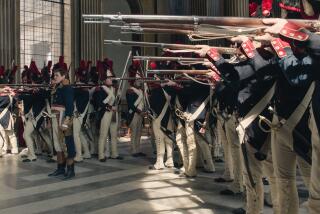Movie review: “The Mill and the Cross” gives a vibrant art-history lesson
- Share via
In “The Mill and the Cross.” Polish-born filmmaker Lech Majewski dramatizes the creation of Pieter Bruegel’s 1564 painting “The Way to Calvary,” a deeply felt response to the Spanish occupation of Flanders.
Working from the painting as an original text, Majewski and co-writer Michael Francis Gibson find threads of narrative within the broad landscape of the canvas and the more than 500 figures depicted there. They also show Bruegel (played by Rutger Hauer, a long way from his recent “Hobo With a Shotgun”) wandering through, at times explaining his thinking and objectives to a friend and potential patron (Michael York).
Combining studio-set filming with some vast and impressive outdoor landscapes, Majewski creates something of a vibrant phantasm, a film that doesn’t seem quite realistic yet feels informed by the rhythms of what it might have been like to live at that time, both in its slow, pastoral beauty and sharp cruelty. The film’s climax, perhaps inevitably, occurs when Majewski finally shows the actual painting in a museum, transforming it from a canvas on a wall into something that seems alive, or at least full of stories and knowledge.
Singular and distinctive, “The Mill and the Cross” is like an art history seminar in vivid motion.
“The Mill and the Cross.” No MPAA rating. Running time: 1 hour, 37 minutes. At the Nuart, West Los Angeles.
More to Read
The biggest entertainment stories
Get our big stories about Hollywood, film, television, music, arts, culture and more right in your inbox as soon as they publish.
You may occasionally receive promotional content from the Los Angeles Times.











